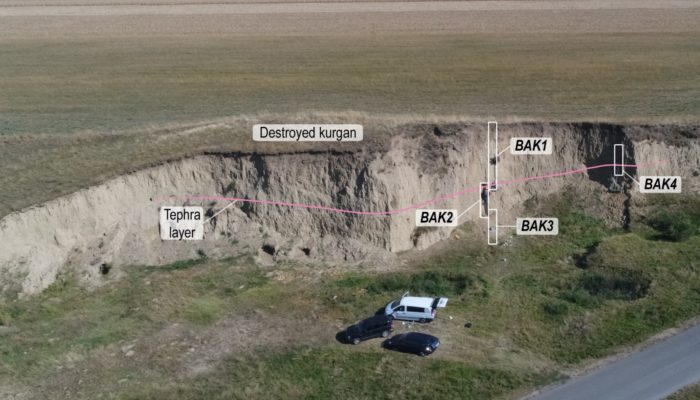
As you have learned from our previous posts, loess is a widespread terrestrial sediment, known to be an important archive for the changes of past environmental and climatic conditions. In order to use loess as a proxy, we first need to investigate the age of the sediments. In loess, different dating methods can be used, such as luminescence dating, radiocarbon dating, magnetic stratigraphy, and orbital tuning. Sometimes more than one method is applied to increase accuracy by cross-validation. However, as dating is usually time-consuming and expensive, it is not feasible to use several dating methods simultaneously in most studies. This blog post summarizes a study where multiple dating methods were combined to achieve a consistent age model for a loess site.
Thick loess deposits in central and southeastern Europe are important archives for paleoclimatic and geochronological investigations. Therefore, we sampled the Balta Alba Kurgan loess-paleosol sequence in Romania in 2018. The team included Dr. Ulrich Hambach, Dr. Daniel Veres, Dr. Stephanie Scheidt, Dr. Janina Nett, PhD student Stephan Pötter and bachelor student Dennis Esmaeili. The sequence is located in the forelands of the Eastern Carpathians and is exposed at the northern slope of a loess plateau. We called the site Balta Alba Kurgan (BAK) after the Balta Alba lake, which is located close to the section, and the cut kurgan. A kurgan is a large pit-grave burial mound; these kurgans are found frequently in the area and are usually around 3000 years old.
After sampling the profile shown in Fig. 1, samples were processed in the laboratories at Cologne University, Germany for radiocarbon, luminescence and magnetic dating. The geochemical composition of the volcanic glass shards of the tephra (i.e. volcanic ash) were analyzed at Bayerisches Geoinstitut at the University of Bayreuth, Germany. During a volcanic eruption, glass shards are formed due to the rapid cooling of the magma and are contained in ash layers. Their geochemical composition is related to the geochemistry of the magma, can be used as a fingerprint of the specific eruptions. When the age of the tephra layer is known from another site, this deposition age can be applied to the same tephra layer found in other deposits. This concept is used in tephrochronology.
Tephra Geochemical Analysis
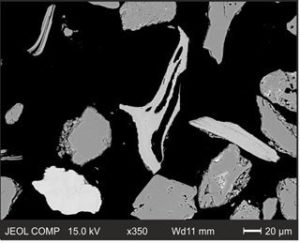
Figure 2: Scanning electron microscope (SEM) images of the glass shards at the Balta Alba Kurgan site (adapted from [1]).
By comparing the geochemical composition of the tephra glass shards from the BAk site with known tephra compositions, the tephra was identified as the so-called ‘Campanian Ignimbrite/Y-5 tephra’, which is dated to an age of ~ 40,000 years [2]. This serves as an independent time-marker for the other dating methods used at the site. Figure 2 shows a microscope image of the sample.
Luminescence Dating
With luminescence dating, one can determine the timing of the deposition of the sediments. Usually, quartz (SiO2) and feldspar minerals ((Ba/Ca/Na/K/NH4)(Al/B/Si)4O8) can be dated directly, which makes it well applicable to loess deposits. At BAK, we tested different protocols and used the tephra layer to determine the most reliable method for dating the outcrop. Figure 3 shows dating of quartz grains, with a grain-size of 4-11 µm, using blue-stimulated luminescence (BSL), and dating of feldspar grains, with grain-sizes of 4-11 µm and 63-90 µm, using infrared stimulation at 50°C (IR50) or post-infrared infrared stimulation (pIRIR) at 290°C. Often the different age data overlap because of the large age uncertainties. For the final age model, we used the fine-grain (4-11 µm) pIRIR data.
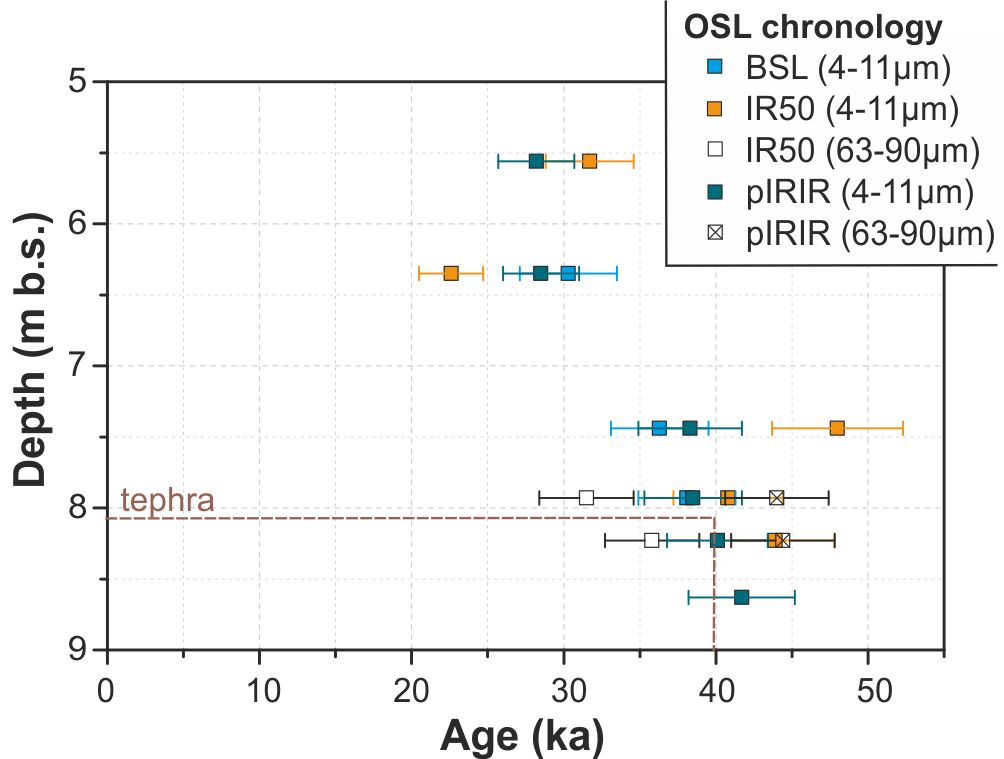
Figure 3: Results of luminescence dating using different protocols and grain-sizes: blue-light stimulated luminescence (BSL), infrared stimulated luminescence (IR50), and post-infrared infrared stimulated luminescence (pIRIR). Age and depth of the tephra layer after [2] is also indicated. Figure from [1]. Where age uncertainties overlap, one can assume the ages to be more accurate. The depicted IR50 ages (white and orange rectangles) had to be corrected for a signal loss, which is common for these signals. This signal loss is called fading and is difficult to measure and correct for. This explains why these age data are always a bit older or younger than the other age data points, which increase more gradually with depth (BSL, pIRIR).
Radiocarbon Dating
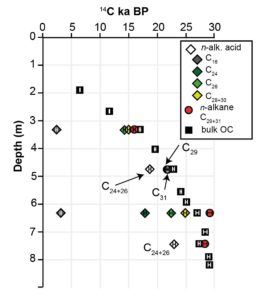
Figure 4: 14C ages analyzed on organic materials from the loess profile BAK. In addition to bulk organic carbon (bulk OC) we analyzed 14C ages of leaf and root biomarkers (n-alkanes and n-alkanoic acids). Figure from [1].
Radiocarbon dating takes advantage of the uptake of the naturally occurring radioactive carbon isotope 14C by living organisms. Based on the radioactive decay constant of 14C the termination of carbon exchange with the environment (the death of the organism) can be determined from organic remains. This point in time ideally coincides with the incorporation of such organic remains (for example wood, leaves, bones, biogenic carbonates) in the sediment and provides information on the timing of sediment deposition. Unfortunately, fossils for 14C dating are rare in loess and this is also the case at BAK. To overcome this problem, we used bulk organic carbon (OC) and organic molecules (biomarkers) to obtain 14C ages (Figure 4). These biomarkers are related to different organic materials like roots or leaves and therefore also have different 14C ages (see 14C ages in Figure 4). 14C-Ages from root biomarkers can be much younger than those of leaf biomarkers in the same sediment layer, because roots penetrate deep into the soil. Biomarkers originating from cuticular waxes of higher plants and bulk OC provided the most reliable ages for actually dating the sediments.
Magnetic Stratigraphy
Magnetic stratigraphy is a correlative dating method. This means that the prominent features of the different magnetic signals measured are tied to their counterparts in independently dated reference records. Thereby, age data results for certain depth levels. For the correlation of the BAK site the so-called relative paleointensity (RPI) and the magnetic susceptibility were used. The magnetic susceptibility is a measure of a material’s ability to be magnetized. It is high if certain minerals are present in large amounts (see here). The RPI reflects the variations of the intensity of the Earth’s magnetic field, which are recorded in the sediment. Figure 5 gives an example for the correlation of the BAK RPI and the global reference curve for Earth’s magnetic field strength GLOPIS.
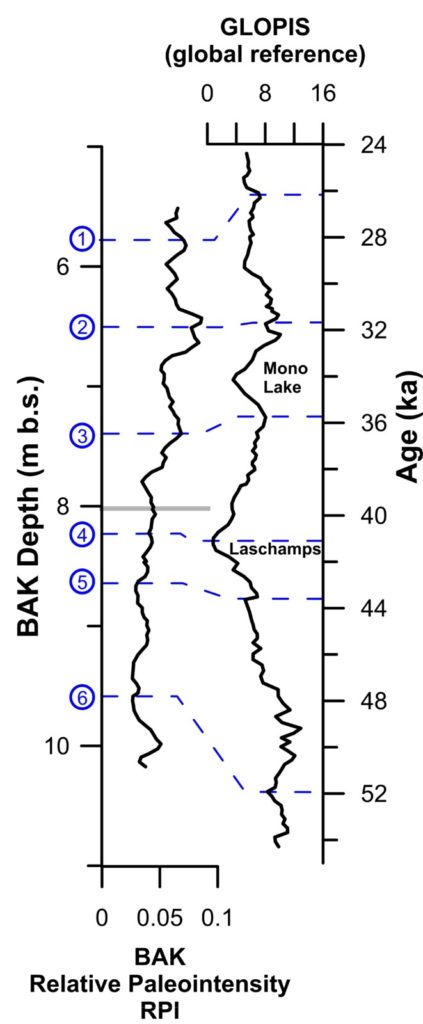
Figure 5: Correlation of the relative paleointensity (RPI) of BAK with the global reference record GLOPIS [3]. The grey line at ~8 m represents the ash layer. 1 to 6 number tie points from which depth of BAK were transferred to age model of the GLOPIS. Mono Lake and Laschamps are geomagnetic excursions associated with RPI minima. Modified after [1].
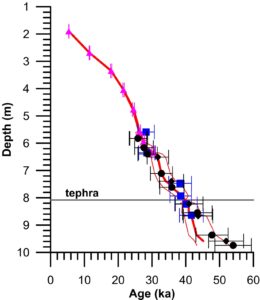
Figure 6: The results of the age-model using the ADMin model [4]. 14C ages are shown in pink triangles, OSL data by blue squares, magnetic stratigraphy by black circles (based on magnetic susceptibility) and black diamonds (based on RPI). The age model and its uncertainties are shown by the red lines (modified from [1]).
Finally, the age data of the single methods were used together to obtain an age-depth model by combining information from all methods. By doing so, we could eliminate systematic offsets inherent to the specific dating methods. Our approach resulted in a combined age-depth model that allowed us to calculate sedimentation rates, which is hardly possible from ages obtained from single methods alone, because of rather high individual uncertainties.
The resulting-age model is robust and an example for what can be achieved when different dating disciplines are combined. In the future, this age model can be used to decipher the paleoenvironmental information preserved within the loess-paleosol sequence. This study is unique as it combines and compares four different dating methods in the same archive and helps us to understand the advantage and disadvantages of each dating method. We hope that more studies like ours will be conducted in the future to test if they reach similar conclusions. We recommend the use of more than one dating method. If you are interested in more details of the study, please check out the open-access publication [1].
This is a co-blog of the EGU divisions of ‘Climate’ and ‘Stratigraphy, Sedimentology and Palaeontology’ and was edited by both editorial boards.
References [1] Scheidt, S., Berg, S., Hambach, U., Klasen, N., Pötter, S., Stolz, A., Veres, D., Zeeden, C., Brill, D. Brückner, H., Kusch, S., Laag, C., Lehmkuhl, F., Melles, M., Monnens, F., Oppermann, L., Rehemeyer, J., Nett, J.J., 2021. Chronological Assessment of the Balta Alba Kurgan Loess-Paleosol Section (Romania) – A Comparative Study on Different Dating Methods for a Robust and Precise Age Model. Frontiers in Earth Science 8: 598448. Doi: 10.3389/feart.2020.598448 [2] Giaccio, B., Hajdas, I., Isaia, R., Deino, A., and Nomade, S., 2017. High-precision 14C and 40Ar/39Ar dating of the Campanian Ignimbrite (Y-5) reconciles the time-scales of climatic-cultural processes at 40 ka. Scientific Reports 7 (1), 1–10. Doi:10.1038/srep45940 [3] Laj, C., Kissel, C., and Beer, J. (2004). High resolution global paleointensity stack since 75 kyr (GLOPIS-75) calibrated to absolute values. Geophysical Monograph 145, 255–265. doi:10.1029/145gm19 [4] Zeeden, C., Dietze, M., and Kreutzer, S., 2018. Discriminating luminescence age uncertainty composition for a robust Bayesian modelling. Quaternary Geochronology 43, 30–39. Doi: 10.1016/j.quageo.2017.10.001

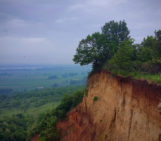
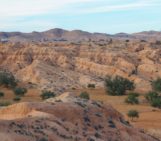
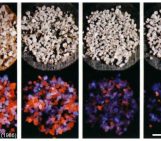
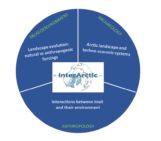
MERIEM
thank you very nice website article
Janina Nett
We are happy you enjoyed it!